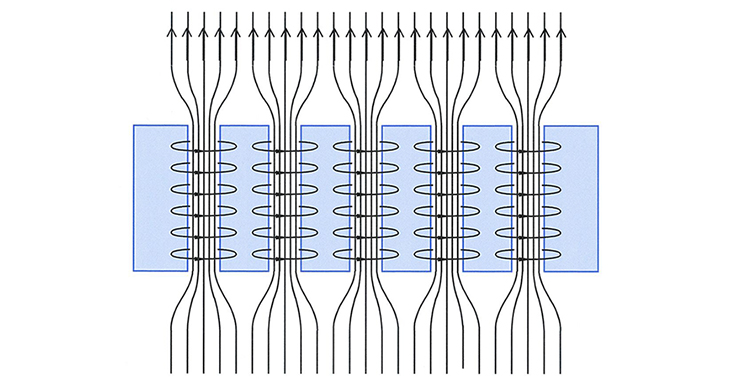Great Scott! How Does Lexus' Hoverboard Actually Work?
(Inside Science) -In the classic 1989 film Back to the Future 2, intrepid time traveler Marty McFly jumps ahead a few decades, to October 21, 2015. Luxury car manufacturer Lexus appears to be ready for him. This week, they announced that they've built a "real, rideable" hoverboard. They've even released video of it, oozing fog and mysteriously floating over what looks like a concrete sidewalk.
Check out the 38-second teaser for yourself:
Of course, McFly might be disappointed to learn he can't buy it; Lexus has no plans to sell the prototype board, Ars Technica reports. But even so, it's really floating there! And on the hoverboard's official website, Lexus hints at how they pulled it off:
The Lexus Hoverboard uses magnetic levitation to achieve amazing frictionless movement. Liquid nitrogen cooled superconductors and permanent magnets combine to allow Lexus to create the impossible.
Now, Lexus, your hoverboard is really cool, but "impossible"? Let's not get ahead of ourselves. Levitation is not only possible but also well understood from a physics perspective. Lexus is taking advantage of key properties of materials called superconductors. As you might expect, these sorts of materials are "super" at conducting electricity: When superconductors are cooled below a certain temperature, their electrons buddy up and move through the material without encountering any sort of resistance.
More specifically, Lexus' use of liquid nitrogen—which has a temperature of -321 degrees Fahrenheit—tells us that they're using a high-temperature superconductor like yttrium barium copper oxide, which is perfect for the kind of levitation Lexus is (Tony?) hawking. Yes, "liquid nitrogen" and "high-temperature" correctly went in the same sentence. Lexus' superconductor probably starts working at about -292 degrees Fahrenheit, which sounds unfathomably cold. However, this temperature is actually quite warm by superconductor standards. The first superconductor ever discovered, in 1911, had to be cooled down to -452 degrees Fahrenheit, only a few degrees warmer than absolute zero, the coldest possible temperature.
So how did Lexus float its high-temperature superconductors? By playing a magnetic trick on them. When a high-temperature superconductor is too warm to work, magnetic fields can pass right through it without a problem. But if you then cool the superconductor down so that it starts working, it gets "stuck" on the magnetic field lines that were passing through it, as if it were caught in a magnetic spiderweb. In other words, superconductors "freeze the flux lines of the field," says Steve Gourlay, the head of the Lawrence Berkeley National Lab's Superconducting Magnet Group, leaving the superconductor embedded in the magnetic field at that particular location.
 A cross-section of a high-temperature superconductor (blue rectangle) "embedded" in a magnetic field (black lines). The magnetic channels through the superconductor are called "quantum vortices." How cool is that? (Wikimedia Commons)
A cross-section of a high-temperature superconductor (blue rectangle) "embedded" in a magnetic field (black lines). The magnetic channels through the superconductor are called "quantum vortices." How cool is that? (Wikimedia Commons)
To levitate the superconductor, all you need to do is embed the superconductor in the magnetic field a couple of inches above some kind of magnetic surface. If you tried to move the superconductor, you'd kickstart circular eddies of electrical current on the superconductor's surface, spawning miniature magnetic fields that work to the superconductor in place. These eddy currents even oppose gravity, pushing off of the surface's magnetic field to keep the superconductor floating in midair.
In normal conducting material such as copper, which resists the flow of electricity, those eddies would weaken. The lack of electrical resistance in superconductors means that once an eddy current starts, nothing can sap its strength. As long as you keep the superconductor cold, it'll stay floating above a magnet, its eddy currents fighting gravity to a draw.
In short, Lexus has come up with a cool way to use superconductors to levitate a hoverboard and its rider, an impressive achievement, if true -- Lexus hasn't provided video of someone riding the board. But by now, you've probably noticed a theme: levitation happens when the superconductor interacts with an outside magnetic field.
And this is where Lexus is giving us a little movie magic. If the superconductors are in the hoverboard, then we need an outside magnetic field for the hoverboard to coast on. This is where Lexus' "permanent magnets" come in. Gourlay suspects that Lexus laid down a bunch of very strong rare-earth magnets underneath the "sidewalk," setting up a magnetic field powerful enough to support both board and, Lexus promises, a rider. In fact, Gizmodo reports that the hoverboard only works on "special metallic surfaces."
This sort of setup is probably too expensive for your everyday skate park. Rare-earth magnets "can be, oh, I don't know, $100 a kilogram?" Gourlay said. "It isn't cheap."
So unless you plan on covering your driveway with thousands of dollars' worth of magnets, this cleverly made hoverboard wouldn't even get you out of your garage.
Even so, Gourlay is intrigued by the prospect of using superconductors—which are used in everything from maglev trains to the Large Hadron Collider—on something like a hoverboard. "I couldn't ride it without breaking my neck," he said, "but that would be kind of cool."
Reprinted with permission from Inside Science, an editorially independent news product of the American Institute of Physics, a nonprofit organization dedicated to advancing, promoting and serving the physical sciences.
Michael Greshko is a science writer based in Washington, D.C., who has written for NOVA Next, the National Academies, and NYTimes.com, among other outlets. He tweets at "@michaelgreshko.
MORE VIDEOS:



